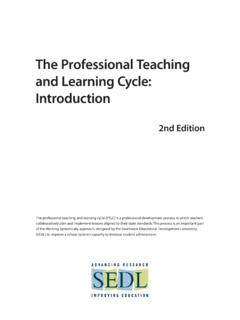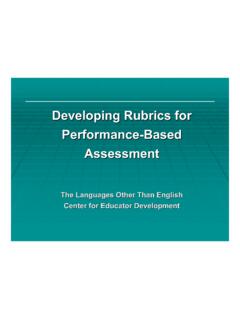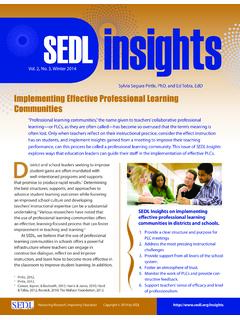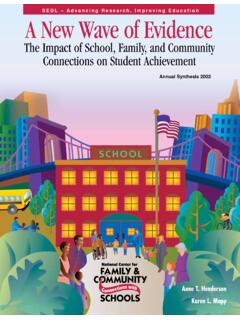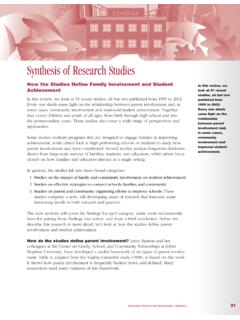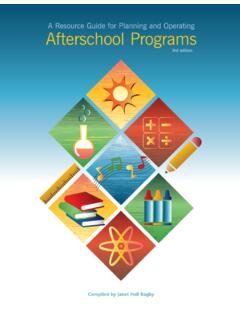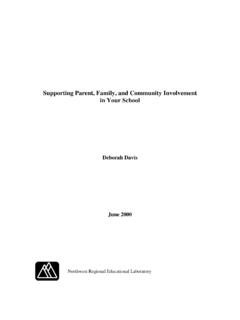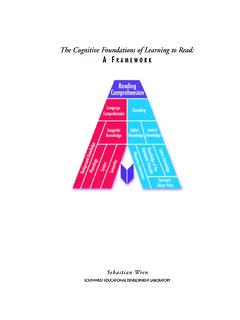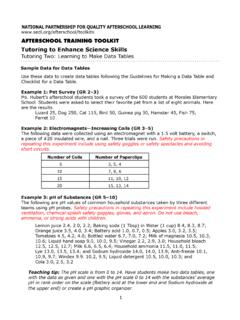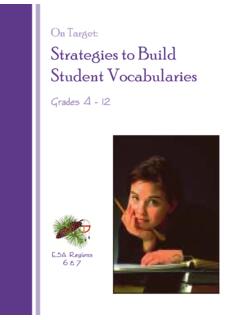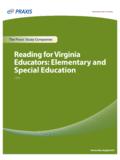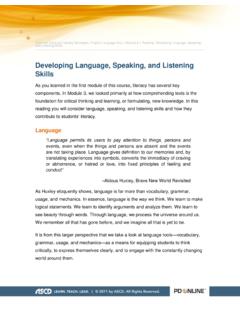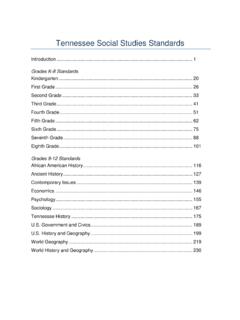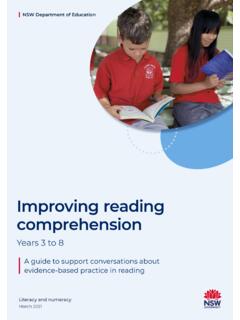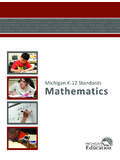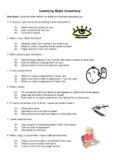Transcription of SEDLinsights - SEDL Archive
1 Research, Improving Education Copyright 2015 by SEDL insightsSEDLR amona Chauvin, PhD, and Kathleen Theodore, MAVol. 3, No. 1, Spring 2015W hen K 12 teachers are asked to identify the challenges students face in learning, one of the major issues often discussed is that students struggle to comprehend the texts that are used in their classrooms. These difficulties are even more pronounced for students in Grades 4 12, where more than 8 million students struggle to comprehend texts in academic content Teachers of different subject areas traditionally have employed content-area2 literacy strategies, an approach to reading instruction that helps students understand information. Content-area literacy focuses SEDL Insights on Teaching Content-Area Literacy and Disciplinary Literacy1.
2 Provide an approach to content instruc-tion that cultivates the skills for 21st century literacy: critical thinking, communication, collaboration, and Take charge of designing authentic, real-world experiences and Commit to a conceptual framework of learning by Provide opportunities for students to use in-quiry, key habits of practice, and academic Implement ongoing, job-embedded profes-sional development and collaboration by discipline with teachers as designers and Content-Area Literacy and Disciplinary LiteracyTo graduate high school fully prepared for college and the workforce, students need more than basic literacy skills. They need to master the distinct approaches to literacy that are used in academic disciplines such as science, mathematics, and history as well as Career Technical Education courses.
3 Many students still struggle to master more basic literacy skills, however, and many teachers in discipline-specific courses lack the knowledge and expertise to help students interpret the complex texts associated with each distinct discipline. This issue of SEDL Insights focuses on two types of literacy that are crucial to helping students become college and career ready: content-area literacy and disciplinary Perie, Grigg, & Donahue, 2005 as cited in Fang & Schleppegrell, Shanahan, Content-Area Literacy and Disciplinary LiteracySEDL Insights / Vol. 3, No. 1, Spring 20152on the similarities of literacy in the content area with general strategies like summarizing, questioning, and making inferences that can help students with comprehension and can be applied universally across content This approach gave rise to the adage all teachers including content-area teachers must be teachers of reading.
4 Many educators and researchers have moved beyond this paradigm, however, and are instead focusing on helping students learn how to access and comprehend discipline-based texts and engage in literacy skills, strategies, and practices specific to each This approach is called disciplinary literacy. As the name suggests, disciplinary literacy focuses on discrete ways reading and writing are used in the specific discipline being As is often the case when new strategies are introduced, there has been some confusion with terminology, with some practitioners using the terms content-area literacy and disciplinary literacy interchangeably. As researcher Timothy Shanahan argues, Disciplinary literacy is NOT the new name for content area reading.
5 6 Rather, it is anchored in the disciplines with explicit instruction focused on discipline-specific cognitive strategies, language skills, and habits of In other words, the idea is not that a Shanahan & Shanahan, 2008. b Shanahan & Shanahan, Lee & Spratley, Bickley, of Instructional Strategies Content-Area LiteracyFocuses on the ability to use reading and writing to learn the subject matter in a discipline; teaches skills that a novice might use to make sense of a disciplinary text. Emphasizes a set of study skills that can be generalized across content Content-area literacy might use strategies such as monitoring comprehension, pre-reading, setting goals and a purpose for reading, activating prior knowledge, asking and generating questions, making predictions, re-reading, summarizing, and making inferences.
6 In a science class, an example of a content-area literacy strategy would be a student using a KWL chart, which is a reading tool that asks what I know, what I want to know, and what I learned. The student would use this chart to identify what he or she already knows, pose questions for reading, and list what he or she has learned during LiteracyFocuses on how reading and writing are used in the discipline being studied. It emphasizes the unique tools that the experts in a discipline use to participate in the work of that discipline. bExamples Disciplinary literacy uses strategies including building background knowledge specific to the discipline, learning specialized vocabulary, deconstructing complex discipline-specific text structures, mapping graphic and mathematical representations against explanations in the text, posing discipline-specific questions, and providing evidence to support and evaluate In a social studies class, for example, students might write journal entries to show their understanding of another culture s way of life or write newspaper articles to analyze a historic event.
7 In a science class, students might write lab reports or proposals for a pharmaceutical 3 Fang & Coatoam, Fang & Coatoam, Fang & Coatoam, Shanahan, Fang & Coatam, Content-Area Literacy and Disciplinary LiteracySEDL Insights / Vol. 3, No. 1, Spring 20153content-area teachers should become reading and writing teachers, but rather that they should emphasize the reading and writing practices that are specific to their subjects, so students are encouraged to read and write like historians, mathematicians, and other subject-area experts .8 Based on our experiences in the classroom and out in the field providing technical assistance to educators and on recent research findings we find that both content-area literacy and disciplinary literacy approaches are instrumental to student The insights described below are intended for teachers of all subjects as well as school and district leaders.
8 Some insights address strategies to be implemented in the classroom, while others outline ways that education leaders can support teachers using both content-area literacy and disciplinary literacy instructional strategies. Examples are based on professional development, coaching sessions, and fieldwork conducted through the Center for High-Performing Schools and the Southeast Comprehensive Center in states such as Mississippi, New Mexico, and South , the Partnership for 21st Century Learning (formerly the Partnership for 21st Century Skills) has identified critical thinking, communication, collaboration, and creativity as learning skills that students need to master to be prepared for an increasingly complex life and This means that teachers cannot just teach students how to understand content; they must also teach students how to think and how to learn.
9 Unlike mathematics, where one skill builds upon another, the process of developing literacy skills is one that requires repeated application of skills, continual learning, and We encourage teachers to guide students in adopting a recursive approach to Provide an approach to content instruction that cultivates the skills for 21st century literacy: criti-cal thinking, communica-tion, collaboration, and : returning to a passage after a first reading, focusing on key passages and details, identifying patterns, and asking questions. As literacy experts in the Center for High-Performing Schools, our role is to help elementary, middle, and high school teachers transform literacy instruction, changing isolated literacy practices to ones that support critical analysis , discussions, and creativity.
10 We employ a range of strategies to help teachers learn to cultivate 21st century literacy skills: We activate teachers prior knowledge by utilizing their current understandings of best practices and what they are already doing to foster disciplinary literacy. For example, we let them know that content-area literacy is still a valuable part of instruction and content-literacy strategies such as summarizing, predicting, and visualizing remain core strategies for content-area literacy. We help teachers become aware of their metacognitive processes by encouraging them to reflect on what they do as they read a text in specific academic disciplines. Through journaling, reflection, and collegial discussion in professional learning communities (PLCs), teachers develop patterns of thinking for literacy in each academic discipline.

